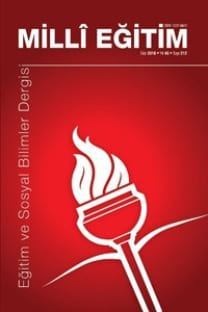TARİH DERSİ SINAV SORULARININ BLOOM TAKSONOMİSİ’NİN BİLİŞSEL ALAN DÜZEYİ AÇISINDAN SINIFLANDIRILMASI
Bu araştırmanın amacı, ortaöğretim tarih öğretmenlerinin 2006-2007eğitim-öğretim yılının tamamı ve 2007-2008 eğitim-öğretim yılının güz döneminde hazırladığı 1735 adet sınav sorusunu, Bloom Taksonomisi’nin bilişselalan düzeyi açısından sınıflandırmaktır. Betimsel yöntemle gerçekleştirilen buçalışmada, veriler doküman incelemesiyle elde edilmiştir. Araştırmanın gerçekleştirildiği 1 fen, 3 Anadolu ve 7 genel liseden oluşan toplam 11 lise, amaçlıörneklemle (Purposive Sampling) seçilirken; incelemesi yapılan 1735 sınavsorusunu hazırlayan 40 tarih öğretmeni, rastgele örneklemle (RandomSampling) seçilmiştir Araştırmadan elde edilen verilere göre; tarih öğretmenlerinin, Bloom Taksonomisi ve taksonomiye dayalı olarak soru hazırlama hakkında yeterli bilgiye sahip olmadığı anlaşılmıştır. Buna ilaveten, tarih dersi sınavlarında en fazla kavrama ve bilgi basamağı sorularının sorulduğu görülmüştür. Başka bir deyişle, tarih öğretmenleri daha ziyade alt düzey düşünmeye yönelik sorular hazırlamışlardır. Sınavlardaki üst düzey soruların tüm sorular içindeki oranının çok sınırlı seviyede kaldığı görülmüştür. Bunların haricinde üç tür liseden Anadolu ve fen liselerinde, genel liselere oranla üst düzey sorulara yetersiz de olsa daha fazla yer verildiği tespit edilmiştir.
CLASSIFICATION OF HISTORY EXAM
QUESTIONS ACCORDING TO COGNITIVE
LEVELS OF BLOOM’S TAXONOMY*
The purpose of this study is to examine and classify 1735 history exam questions which asked during 2006-2007 and in the fall term of 2007-2008 in the light of the cognitive levels of Bloom’s Taxonomy. Descriptive method was used to gather data in this research and data collection tool of this research is document analysis. Purposive Sampling was used to choose high schools in the province of Trabzon. Besides this, Random Sampling was also used to choose 40 history teachers. In the light of the data, it was seen that history teachers joined the research do not have sufficient knowledge and experience about the Bloom’s Taxonomy and the questioning in the light of this taxonomy. They were also seen to ask questions towards the lower-level thinking skills through the comprehension and knowledge levels of the Bloom’s Taxonomy. Furthermore, the ratio of the higher-level and more complex questions to the remaining questions in the study was seen to be very limited. It was also determined that among the high schools in the study, higher-level questions were asked in the Anatolian high schools and high schools of science more than the regular high schools.
